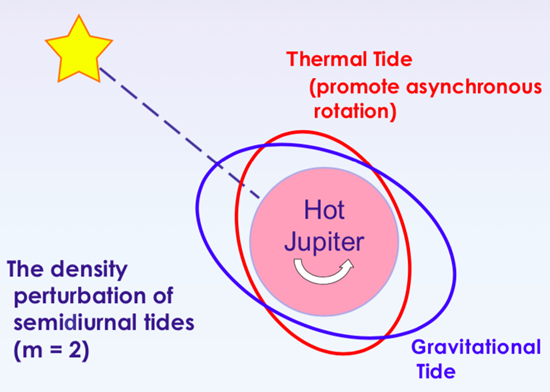Research Gallery > The Theoretical Astrophysics (Theory)
Research Gallery
The Theoretical Astrophysics (Theory)
| A Hot Jupiter Bloated by a Thermal Bulge |
|
Image Credit: Pin-Gao Gu

A thermal bulge of a hot Jupiter is excited by stellar irradiation against a gravitational bulge, thereby maintaining an asynchronous rotation of the planet and preventing the planet from gravitational contraction (the figure was originally made by Ginny Wei). This research result was highlighted on the MOST GASE webpage at http://trh.gase.most.ntnu.edu.tw/en/article/content/132.
|
| We revisit the problem of thermal bulge of asynchronous hot Jupiters, using HD 209458 b as a fiducial study. We improve upon previous works by using a double-gray atmosphere model and interior structure from MESA as the background state, and then solve for the thermal bulge in response to the semidiurnal component of stellar insolation. The atmosphere model is based on the radiative transfer with Eddington’s two-stream approximation. Two opacity cases are considered: the first introduces a greenhouse effect and the second exhibits a strong temperature inversion. We find that for the predominant thermal bulges excited by g-modes of lower orders, our results are qualitatively similar to the adiabatic results from Arras & Socrates (2010). It arises because the perturbed heating due to self-absorption of thermal emissions can be significant (i.e., greenhouse effect) against Newtonian damping, thereby leading to almost undamped thermal bulges. We also find that the contribution to the thermal bulge from the evanescent waves in the convective zone is not negligible, implying that the thermal bulge is not merely confined in the atmosphere and radiative envelope. Assuming the torque balance between the thermal and gravitational bulges, we estimate the tidal quality factor of the planet for gravitational tides to match the observed radius (Gu, Peng, & Yen 2019, Astrophysical Journal, 887, 228). |
 asiaa.sinica.edu.tw Media Request: epo
asiaa.sinica.edu.tw Media Request: epo asiaa.sinica.edu.tw
asiaa.sinica.edu.tw 
